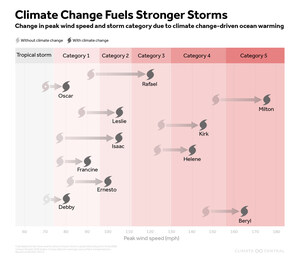Study pinpoints coastal wetlands capable of surviving climate change--with human help
PRINCETON, N.J., June 8, 2022 /PRNewswire/ -- Climate Central today announced the publication of a new peer-reviewed study and interactive mapping tool showing American coastal wetlands' resilience to climate change. The maps incorporate the study's findings to reveal precise locations where wetlands might survive rising seas either by migrating upland or by growing higher to stay above rising water levels.
But the study, published in Environmental Research Communications, finds that rising seas threaten to drown most coastal wetlands by 2100—despite their unique abilities to adapt—unless planners preserve enough adjacent land to accommodate migration, and nations reduce greenhouse gas emissions to slow the pace of global warming and sea level rise.
The southern Atlantic and Gulf coasts face the highest risks of wetlands loss by the end of this century. The risks are most acute in Louisiana (home to one-third of America's coastal wetlands), North Carolina, and Texas. Risks in California and Florida are magnified because their wetlands have limited undeveloped land to migrate to. Climate Central maps specifically identify where conservation efforts and climate action can reduce the loss of coastal wetlands, or in some cases allow them to expand, even as sea levels rise.
"Coastal wetlands are racing for survival against climate change. This research and the mapping tools it supports can help residents see where local and global actions can give their valuable wetlands the best chance of winning," Benjamin Strauss, CEO and chief scientist of Climate Central said.
Coastal wetlands reduce flooding and the impacts of storms in residential areas, provide vital wildlife habitat, naturally filter pollution, and store carbon. Tim Dillingham, executive director of the American Littoral Society said, "Rising seas mean more wetlands are giving way to open water, and their important benefits are disappearing with them. But these are resilient, dynamic systems. They can grow higher and even move into new areas, and we must take action to support them."
Counties with the most to gain or lose
Top ten U.S. counties where conserving land for wetlands migration makes the largest difference in the projected change (by percentage) in wetlands area by 2100, under a scenario of high emissions (RCP 8.5) and moderate wetlands growth rate.
County |
Increase in wetland area with full conservation |
Decrease in wetland area with full development |
Liberty County, Texas |
3023% |
-100% |
Harford County, Maryland |
1422% |
-88% |
West Baton Rouge County, Louisiana |
1155% |
-100% |
Seminole County, Florida |
355% |
-99% |
Baltimore County, Maryland |
356% |
-98% |
Kenedy County, Texas |
311% |
-100% |
Washington County, Florida |
301% |
-100% |
Lafayette County, Louisiana |
297% |
-100% |
Kleberg County, Texas |
207% |
-100% |
Rensselaer County, New York |
267% |
-37% |
For many coastal communities, preserving local wetlands is important to a broad range of stakeholders. Dr. Dale James, Ducks Unlimited director of conservation science and planning said, "Ducks Unlimited's wetland conservation efforts provide ecological, economic and societal benefits. We are making communities more sustainable and resilient by protecting and enhancing natural habitats that support tourism, outdoor recreation, the seafood and energy industries, as well as other important infrastructure vital to our country. These wetland ecosystems provide critical wildlife habitat as well as an improved quality of life for people through connection with nature."
- Localizable maps showing where wetlands can survive, expand, or recede, by decade, depending on coastal development, pollution pathways/sea level rise scenarios, and wetlands' rate of vertical growth: https://coastal.climatecentral.org/map/?theme=wetlands&map_type=annual_accretion
- County-level maps projecting total gains/losses of coastal wetlands by decade, based on coastal development, pollution pathways/sea level rise, and wetlands' rate of vertical growth: https://coastal.climatecentral.org/map/?theme=wetlands&map_type=area_change
- The study on which the maps are based, published today in the peer-reviewed journal Environmental Research Communications, can be read in full here.
Climate Central is a non-advocacy, non-profit science and news organization providing authoritative information to help the public and policymakers make sound decisions about climate and energy.
SOURCE Climate Central

WANT YOUR COMPANY'S NEWS FEATURED ON PRNEWSWIRE.COM?
Newsrooms &
Influencers
Digital Media
Outlets
Journalists
Opted In






Share this article